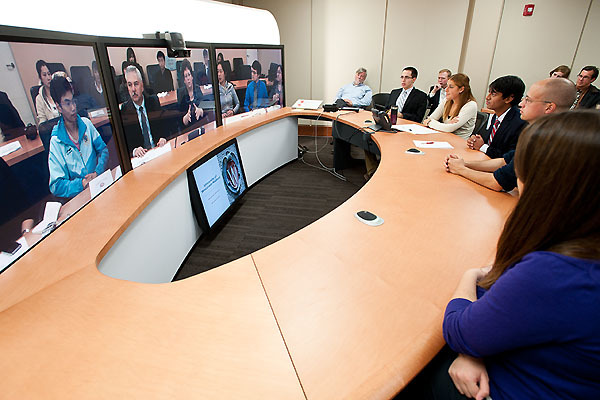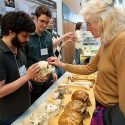Hi-def group videoconferencing offered on campus

Students take part in a TelePresence videoconference in the Education Building with UW–Madison representatives visiting Beijing, China in November 2010. A second campus TelePresence unit is at the Wisconsin Institutes for Discovery.
If you need to meet with people located beyond Madison — or even within it — but can’t get everyone in the same room, a convenient service on campus may help.
Two spots, one located in the Wisconsin Institutes for Discovery building and the other on Bascom Hill in the Education Building, offer high-definition, low-delay videoconference equipment designed to make people feel like they are meeting face-to-face instead of screen-to-screen. The technology, called Cisco TelePresence, allows connections to multiple sites and multiple types of end-point devices and is built into speciallydesigned conference rooms on campus.
The difference between TelePresence and other videoconferencing systems is as the name suggests — distant participants seem like they are local due to the three-screen HD video quality and low delay. TelePresence captures nuance and richness of expression, gestures, voice range and graphic images — without the delay in voice or image delivery common in standard teleconference systems.
TelePresence captures nuance and richness of expression, gestures, voice range and graphic images — without the delay in voice or image delivery common in standard teleconference systems.
Guest speakers for classes, research collaborations, performances, employee interviews and dissertation defenses — these all are meetings that can benefit from use of this technology, which can connect with fixed and mobile devices, similar TelePresence rooms, personal computers, iPads or smart phones.
The nearly identical facilities are equipped with technology made possible through donations by UW–Madison alumni John and Tashia Morgridge. UW–Madison faculty, staff, students and partners can reserve and use either room.
Technical support staff at each site share instructions and work with meeting organizers to set up the rooms and network connections, which can link participants within a few miles of each other or across international date lines. Discovery, DoIT, Education and WARF staff strive to offer TelePresence at no cost to users. However, in some cases it may be necessary to pass along the cost of outside service providers.
The Discovery TelePresence room can accommodate up to 18 participants and the Bascom Hill site can serve up to 14. Both rooms also can seat additional viewers and can connect simultaneously with multiple sites. Connections are possible with thousands of TelePresence and other fixed camera videoconferencing rooms, or can be dialed in remotely with a laptop, tablet computer or smart phone.
TelePresence videoconferences may be the answer if you are struggling to schedule a meeting with people at other institutions or colleagues who are traveling, or build relationships among remote teams. Both can be reserved online. Scheduling in advance ensures availability of the room when you need it, encourages pre-meeting planning and allows timely notifications to participants of time and passcode information.


